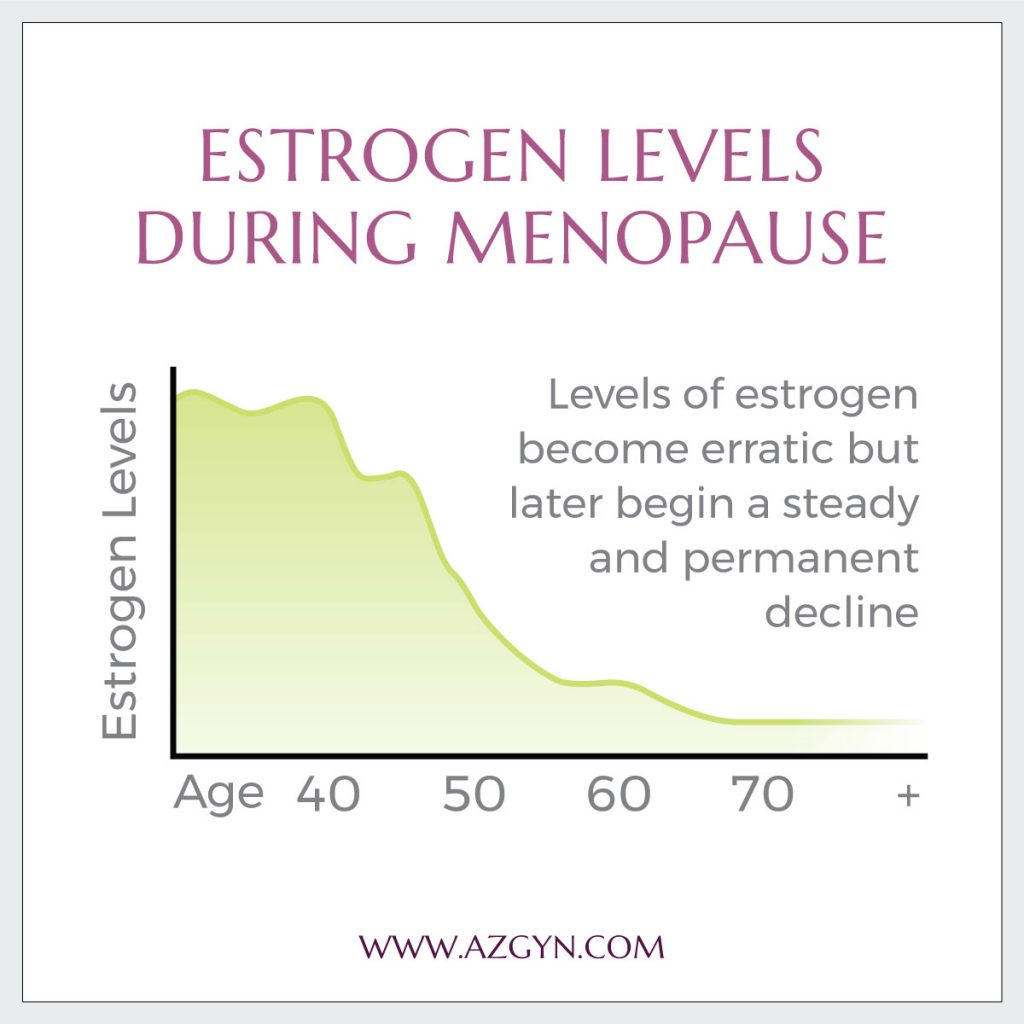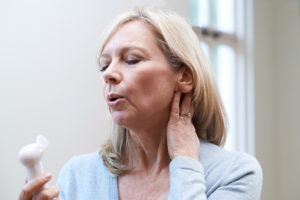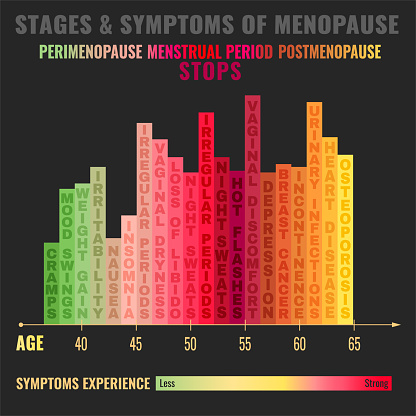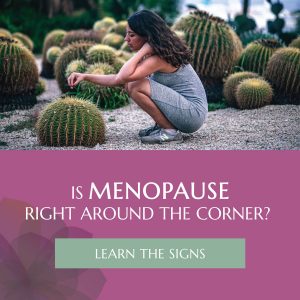The menopausal transition, or simply “menopause,” is a normal part of female aging. Once you start the transition, you’ll probably want to know exactly how long symptoms will last.
While every woman is different, here’s what to expect on average.
About Menopause
 All women experience menopause, with several different symptoms.[1]Sussman, M., Trocio, J., Best, C., Mirkin, S., Bushmakin, A. G., Yood, R., Friedman, M., Menzin, J., & Louie, M. (2015). Prevalence of menopausal symptoms among mid-life women: findings from … Continue reading The symptoms vary from woman to woman, and menopause is as unique a journey as the woman herself.
All women experience menopause, with several different symptoms.[1]Sussman, M., Trocio, J., Best, C., Mirkin, S., Bushmakin, A. G., Yood, R., Friedman, M., Menzin, J., & Louie, M. (2015). Prevalence of menopausal symptoms among mid-life women: findings from … Continue reading The symptoms vary from woman to woman, and menopause is as unique a journey as the woman herself.
Menopause symptoms may include:
- Hot flashes
- Chills
- Sleep problems / insomnia
- Mood Swings / irritability
- Pain during sex / vaginal dryness
- Depression
- Dry skin, dry eyes or dry mouth
- Urinary urgency (a pressing need to urinate more frequently)
In few cases, women don’t have trouble with these symptoms. Once the menopausal transition is complete, you will no longer have to worry about periods or getting pregnant.

For most women, menopause is a relief that feels freeing in many ways. Getting through the transition, however, can be trying.
Knowing about how long your symptoms will last can help you focus on the light at the end of the tunnel. While you’re going through abrupt hot flashes and night sweats that keep you awake at night as well as irritability from lack of sleep, knowing that you’re just X amount of days from it being over can ease your mind.
Related Reading: Identify the Signs of Menopause [Infographic]
While there is no guarantee of exactly how long the transition will last, you can get a good idea of where you are on the journey by understanding the process and studying an average timeline.
The Average Timeline for Menopause
The menopause age range varies by more than a decade. The average age is 51, but menopause can start in women from their mid-40s to late 50s. Most women experience the menopause stage in this age range, while some report symptoms into their 60s. [2]Gold E. B. (2011). The timing of the age at which natural menopause occurs. Obstetrics and gynecology clinics of North America, 38(3), 425–440. https://doi.org/10.1016/j.ogc.2011.05.002
Natural menopause happens in three stages:
- Perimenopause
- Menopause
- Postmenopause
Sometimes perimenopause is confused with menopause. Perimenopause is when a woman starts to have hot flashes, night sweats and vaginal dryness. This can start as early as the 30’s or as late as the 60’s. This is considered either early or premature menopause and late menopause, and can occur for a variety of reasons, such as surgeries or hormonal changes.
Some women in perimenopause may also have the following symptoms:
- Breast tenderness
- Worsening of premenstrual syndrome (PMS)
- Irregular periods or skipping periods
- Periods that are heavier or lighter than usual
Additional symptoms may include:
- Racing heart
- Headaches
- Joint and muscle aches and pains
- Changes in libido (sex drive)
- Difficulty concentrating, memory lapses (often temporary)
- Weight gain
- Hair loss or thinning
These symptoms are normal as part of the loss of estrogen production.[3]Iqbal, J., & Zaidi, M. (2009). Understanding estrogen action during menopause. Endocrinology, 150(8), 3443–3445. https://doi.org/10.1210/en.2009-0449 However, if these are new symptoms after starting perimenopause, consult your doctor in order to rule out other health issues.
Menopause that occurs before the age of 45, regardless of the cause, is called early menopause. Menopause that occurs at 40 or younger is considered premature menopause. Perimenopausal symptoms and age will be as individual as each woman. Talk to your doctor if you’re not sure whether you’re beginning the menopausal transition.
Contributing Factors
Primary Ovarian Insufficiency (POI) is another cause of premature menopause. With POI, younger women under 40, who have occasional or no periods, and elevated levels of follicle-stimulating hormone (FSH), will have fewer eggs in their ovaries. This means lower estrogen levels as well and can cause bone density issues.
 According to the SWAN (Study of Women Across the Nation) study, smoking, either as a current smoker or former smoker, can also cause early onset of perimenopausal symptoms, such as hot flashes and night sweats, by at least two years.[4]Whitcomb, B. W., Purdue-Smithe, A. C., Szegda, K. L., Boutot, M. E., Hankinson, S. E., Manson, J. E., Rosner, B., Willett, W. C., Eliassen, A. H., & Bertone-Johnson, E. R. (2018). Cigarette … Continue reading Being overweight, stressed, depressed, or anxious can also start the ball rolling early. Ethnicity also plays a factor. African American women have a longer period of hot flashes – almost 11 years, while Japanese and Chinese women had half the time of dealing with hot flashes.[5]McKnight, K. K., Wellons, M. F., Sites, C. K., Roth, D. L., Szychowski, J. M., Halanych, J. H., Cushman, M., & Safford, M. M. (2011). Racial and regional differences in age at menopause in the … Continue reading
According to the SWAN (Study of Women Across the Nation) study, smoking, either as a current smoker or former smoker, can also cause early onset of perimenopausal symptoms, such as hot flashes and night sweats, by at least two years.[4]Whitcomb, B. W., Purdue-Smithe, A. C., Szegda, K. L., Boutot, M. E., Hankinson, S. E., Manson, J. E., Rosner, B., Willett, W. C., Eliassen, A. H., & Bertone-Johnson, E. R. (2018). Cigarette … Continue reading Being overweight, stressed, depressed, or anxious can also start the ball rolling early. Ethnicity also plays a factor. African American women have a longer period of hot flashes – almost 11 years, while Japanese and Chinese women had half the time of dealing with hot flashes.[5]McKnight, K. K., Wellons, M. F., Sites, C. K., Roth, D. L., Szychowski, J. M., Halanych, J. H., Cushman, M., & Safford, M. M. (2011). Racial and regional differences in age at menopause in the … Continue reading
How Long is Menopause?
The perimenopausal stage can last from 10 months to four years on average, but has been known to last up to 10 years. It involves the body gradually decreasing in estrogen production until the last year or two, when estrogen levels drop dramatically. Perimenopause officially ends when a woman does not have her period for 12 consecutive months.

The woman is now at menopause. This is a point in time, rather than a period of time. The period of time after menopause is called postmenopause. Perimenopausal symptoms, such as hot flashes and night sweats may continue for another few months or even years after menopause has been reached.
Other symptoms that may continue are sleep problems, cognitive issues, mood changes and muscle and joint pain. Vaginal dryness is a symptom that will continue and tends to get worse with age. Although, less than 30% of women experience it during perimenopause and only half experience it in postmenopause.
So, how long does menopause last? From the start of perimenopause to the final cessation of all menopausal symptoms, the average transition takes between two and 10 years. There are some women who go through the process more quickly or more slowly than the median time.
If you experience early or late menopause, you may need to add or subtract a year or two to this average timeline. Every woman should rely on medical professionals to assess symptoms, estimate the duration and prescribe treatments for symptom relief.
Do You Have Early or Late Menopause?
Figuring out if you’re going through the transition early or late can help you gain a better understanding of how long menopause will last. If you start having irregular periods in your mid-40s, you may be experiencing early or premature menopause.
Heavy bleeding, spotting, a period after a year of no periods, or periods that are noticeably longer or shorter than normal can all signal early menopause, especially in combination with other common menopausal symptoms.
If you are 55 or older and still haven’t noticed menopause symptoms, your doctor may diagnose you with late-onset menopause.
Late menopause may actually have some health benefits, while early menopause could potentially cause problems. During menopause, the production of estrogen and progesterone by the ovaries declines. In early-onset menopause, this cessation may cause problems such as osteoporosis. The longer your ovaries produce estrogen and progesterone, the longer you can avoid osteoporosis.[6]Papadakis, G., Didier, H., Gonzalez-Rodriguez, E., Vollenweider, P., Waeber, G., Marques-Vidal, P.M., Lamy, O., (2016). The Benefit of Menopausal Hormone Therapy on Bone Density and Microarchitecture … Continue reading
If you’re still having periods in your late 50s and 60s, see your doctor. Each woman’s reproductive system is different, so don’t be alarmed until you’ve spoken to a doctor.
Treating Menopause Symptoms
You may experience one or several symptoms, or hardly any symptoms at all. You may not notice perimenopausal symptoms until you’ve almost reached the menopause phase. Your entire transition could finish in just a few years, or could last longer than a decade.
Everyone is unique, and there is no concrete answer. It takes seeing a primary doctor to evaluate your symptoms, locate where you are on the general timeline, and estimate how much longer you will have to put up with symptoms.
 While you are combating symptoms for an unknown period of time, look into common forms of relief. If you have medical conditions exacerbating the symptoms of menopause, such as arthritis, chronic pain, anxiety or depression, your doctor can help address these issues to potentially reduce menopause symptoms.
While you are combating symptoms for an unknown period of time, look into common forms of relief. If you have medical conditions exacerbating the symptoms of menopause, such as arthritis, chronic pain, anxiety or depression, your doctor can help address these issues to potentially reduce menopause symptoms.
Menopause is a normal part of life, and several tried-and-true treatment options exist to help control and tolerate common symptoms. You can maintain your desired lifestyle while experiencing menopause with a tailored treatment plan. We have expert women’s health services, if you are seeking a gynecologist in Phoenix. Talk to us about your symptoms and concerns, especially if your perimenopausal symptoms negatively affect your quality of life. We’re here to help.

Founder and Medical Director of ARIZONA GYNECOLOGY CONSULTANTS
Dr. Kelly Roy is a specialist in surgical gynecology and advanced laparoscopy (and hysteroscopy). She is a long-time resident of Arizona and obtained her Bachelor of Science degree in Biomedical Engineering at Arizona State University before finishing her Doctorate of Medicine at the University of Arizona in 1997.
Dr. Roy completed her residency in Obstetrics and Gynecology at the then “Banner Good Samaritan Hospital” (now Banner University Medical Center), in Phoenix Arizona in 2001.
Well known for her teaching and surgical ability, she is on the faculty at the residency program at both Banner University Medical Center and Saint Joseph’s Hospital in central Phoenix and is a Clinical Assistant Professor of Medicine at the University of Arizona College of Medicine, Phoenix Campus. Dr. Roy has taught advanced surgical techniques to medical students, residents, fellows and colleagues for over 15 years.
Dr. Roy is also a consultant to the medical device industry and has participated in the design and clinical testing of many instruments and surgical devices available on the world-wide market today.
Read More About Dr. Kelly Roy, MD | WebMD Profile | Health.USNews.com Profile | Current Obstetrics and Gynecology Reports: TFA with the Sonata System
References
| ↑1 | Sussman, M., Trocio, J., Best, C., Mirkin, S., Bushmakin, A. G., Yood, R., Friedman, M., Menzin, J., & Louie, M. (2015). Prevalence of menopausal symptoms among mid-life women: findings from electronic medical records. BMC women’s health, 15, 58. https://doi.org/10.1186/s12905-015-0217-y |
|---|---|
| ↑2 | Gold E. B. (2011). The timing of the age at which natural menopause occurs. Obstetrics and gynecology clinics of North America, 38(3), 425–440. https://doi.org/10.1016/j.ogc.2011.05.002 |
| ↑3 | Iqbal, J., & Zaidi, M. (2009). Understanding estrogen action during menopause. Endocrinology, 150(8), 3443–3445. https://doi.org/10.1210/en.2009-0449 |
| ↑4 | Whitcomb, B. W., Purdue-Smithe, A. C., Szegda, K. L., Boutot, M. E., Hankinson, S. E., Manson, J. E., Rosner, B., Willett, W. C., Eliassen, A. H., & Bertone-Johnson, E. R. (2018). Cigarette Smoking and Risk of Early Natural Menopause. American journal of epidemiology, 187(4), 696–704. https://doi.org/10.1093/aje/kwx292 |
| ↑5 | McKnight, K. K., Wellons, M. F., Sites, C. K., Roth, D. L., Szychowski, J. M., Halanych, J. H., Cushman, M., & Safford, M. M. (2011). Racial and regional differences in age at menopause in the United States: findings from the REasons for Geographic And Racial Differences in Stroke (REGARDS) study. American journal of obstetrics and gynecology, 205(4), 353.e1–353.e3538. https://doi.org/10.1016/j.ajog.2011.05.014 |
| ↑6 | Papadakis, G., Didier, H., Gonzalez-Rodriguez, E., Vollenweider, P., Waeber, G., Marques-Vidal, P.M., Lamy, O., (2016). The Benefit of Menopausal Hormone Therapy on Bone Density and Microarchitecture Persists After its Withdrawal, The Journal of Clinical Endocrinology & Metabolism, Volume 101, Pages 5004–5011, https://doi.org/10.1210/jc.2016-2695 |


